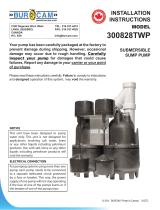
INSTALLATION (New Pump)
1. Set your new pump in the bottom of the basin off to one side. The pump should be
placed on a solid foundation.
2. Make sure the float switch will swing freely from the bottom to top without coming in
contact with the side of the basin. A minimum of 1” clearance is recommended. Contact
with the side of the basin may cause the switch not to operate properly and malfunction.
See figure below.
3. Install a full flow, swing type check valve (not included) as close to the discharge outlet
on the pump as possible. A new check valve will greatly increase the life of your pump,
and should be the same size as the pump discharge, in this case 2”.
4. Connect the pump and check valve together using schedule 40 (recommended) DWV
pipe and fittings.
5. Test your installation after you have completed setting up the pump and connected all
piping. First, plug the piggyback plug from the float switch in to the grounded outlet.
Next, plug the power cord from the pump into the piggyback plug on the float switch. The
pump should not run at this point. If the pump runs, the switch is stuck in the upright
position or the pump is plugged directly into the outlet and not through the piggyback
switch plug. Fill the basin with water using buckets or a hose. When the switch floats to
the upright position, the pump will turn on. The switch will turn off the pump when it
reaches the down position. The switch is set at the factory to turn on at 14” and off at 6”.
You may adjust the switch to meet your particular needs. Remember the switch must
swing freely without touching the sides of the sump basin.
WARNING
Sewage and effluent can develop dangerous and harmful fumes. For safe and secure
operation in this environment it is required to use schedule 40 pipe or heavier. This is
required by the UPC (Universal Plumbing Code) and is for your safety.
WARNING
Besides the fact that it smells terrible, the fumes developed by sewage and effluent can be
very dangerous to your health, even fatal.
WARNING
In a sewage/effluent installation use only an approved tank that is totally sealed and approved
for that use by the manufacturer. The UPC (Universal Plumbing Code) requires it. Your
Superior Pump will provide you with safe and reliable service when installed in the correct
environment. IF YOU ARE UNSURE, contact your local code authority, supplier, or call us at:
1-800-495-9278. You can also contact us on the web at www.superiorpumpco.com
TROUBLESHOOTING
PROBLEM POSSIBLE CAUSES HOW TO CORRECT
If the pump does not start
or run
Pump is not plugged in, switch or
breaker is off
Plug pump in or turn on
switch/breaker
Check for blown fuses or tripped circuit
breakers or tripped GFCI outlets
Replace fuse, reset breaker, reset
GFCI outlet
Float switch is defective Check and replace if necessary
Motor thermal protector tripped Allow pump to cool. Pump will reset
Float switch is stuck or obstructed
Remove obstruction or position pump
so it will not become stuck
The pump starts and
stops too often
Backflow of water from discharge
hose/pipe
Install or replace check valve
Float switch is defective Replace float switch
If the pump runs but
moves little or no water
Clogged discharge hose/pipe Remove clog
Frozen discharge hose/pipe Allow hose/pipe to thaw
Pump is air locked
Clean out airlock hole with a paper
clip or pipe cleaner
Low line voltage
Check wire size and increase if
necessary
Check valve is stuck in the closed
position
Inspect, repair or replace if necessary
Check valve is installed backwards
Make sure check valve is installed in
the correct direction of flow
Worn, damaged or clogged pump parts
Inspect for wear, damage or clog and
clean or replace if necessary
Discharge head exceeds pump capacity
If pumping height is over 25’, the
pump will not move water. See
performance chart
Pump does not
shut off
Float switch is obstructed or stuck Remove obstruction
Defective Float Switch Replace switch
. Grounded Outlet. A GFCI outlet
is strongly recommended.
B. Discharge Pipe
C. Full-flow swing type check valve
D. Position pump so the float switch
operates freely without touching
the sides of the basin.
E. Vent Pipe
4 5







